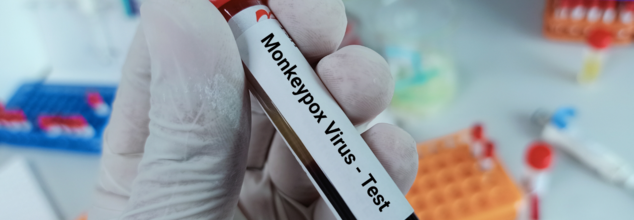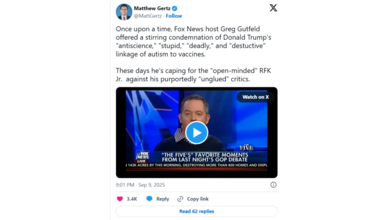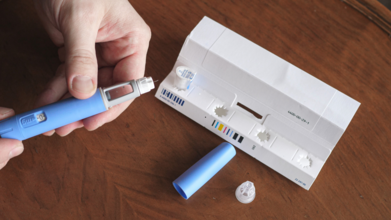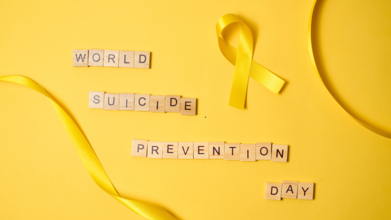- Health Conditions A-Z
- Health & Wellness
- Nutrition
- Fitness
- Health News
- Ayurveda
- Videos
- Medicine A-Z
- Parenting
- Web Stories
Mpox Outbreak: Virus Spreads In US Prison, Infects Inmates

Second time in two years, the World Health Organisation (WHO) has declared mpox as a global health emergency. The virus has already killed over 600 people and new cases have been reported in Europe and Asia. As of September 3, as per WHO, there are a total of 102,997 laboratory-confirmed cases, 186 probable cases and 223 deaths globally. The global data is up to July 31.
Virus In The US Prison
With the cases being on the rise, the virus has been reported with confirmed cases at the Fort Dodge Correctional Facility in the US. However, it is the less serious strain clade II that is detected, though the source and the reason for spread is unknown. The Fort Dodge Correction Facility is Iowa has a population of 1,251. However, the prison staff have told the local press that the situation is under control.
"We are actively managing the situation with robust health measures," said the Iowa Department of Corrections Chief of Staff Paul Conelius. "Affected individuals are receiving care, and enhanced sanitation and isolation protocols are in place to prevent further spread," he said.
As of now, mpox clade I is not found in the United States, however, the Department of Health and Human Services (HHS) stated that when it is found, the virus will "cause lower morbidity and mortality in the United States" than it has in Africa.
What Is Mpox?
Mpox, a zoonotic disease primarily found in the tropical rainforests of central and west Africa, is generally a self-limiting illness, with symptoms lasting 2 to 4 weeks. The World Health Organisation declared it a global health emergency.
Signs And Prevention
There are certain common signs and symptoms of mpox, which show within 14 days of being infected. The signs include fever, sweating, chills throughout the body, rashes, swollen lymph nodes, migraine, muscle aches, fatigue, weakness and back pain.
The infection can spread by skin-to-skin contact, to prevent it, avoid close contact, and wear clothes that cover your skin.
Hydrate yourself, avoid social gatherings. Seek doctor’s help in case you suffer from extreme chills, body pain and fever.
Where Measures Is India Taking?
The centre has informed authorities in airports, ports and borders with Bangladesh and Pakistan to remain alert for the international passengers showing symptoms of mpox, as per a PTI report.
The ministry has also designated three Centre-run hospitals in Delhi - Ram Manohar Lohia Hospital, Safdarjung Hospital, and Lady Hardinge Medical College as the key centres for isolation for anyone showing mpox symptoms. These centres will manage and treat the mpox patients.
State governments have identified and designated similar hospitals within their regions.
The Principal Secretary to the PM, Dr PK Mishra also held a high-level review meeting to discuss India's preparedness for mpox and discussed preventive measures to ensure health safety.
Directions are also given for early diagnosis in 32 labs that are equipped with testing. The centre is also focusing on disseminating information on safety protocols and awareness among the healthcare providers to identify the symptoms and treatment of mpox.
Television Host Greg Gutfeld's Decade Old Video Of Slamming Trump's Anti-Vaccine Views Resurfaces, Why Does It Matter Now?

Credits: HHS.gov, and Snippet from Fox News
A decade-old clip of Fox News host Greg Gutfeld has resurfaced recently. In that video, Gutfeld can be seen fiercely defending vaccines, and calling out Donald Trump for spreading anti-vaccine rhetoric. The video that made waves is going viral again, sparking fresh debate over how the right’s stance on public health has shifted in the years since.
The resurfaced clip, originally aired on The Five in September 2015, shows Gutfeld taking direct aim at then-candidate Trump, who had linked vaccines to autism during a Republican primary debate. “This is a really bad thing to happen to the Republican Party, an anti, hysterical anti-science point of view about vaccines,” Gutfeld said at the time. “Using the anecdote with a child is destructive and it’s ignorant because it’s not science.”
He didn’t hold back, calling the claim “stupid,” “dangerous,” and “bad for Republicans.”
A Clip From the Past: Why Is It Relevant Today?
The clip was compiled and circulated by Media Matters for America this week, drawing attention to how starkly Gutfeld’s position appears to have shifted since those pre-Trump years. The timing of its resurgence is no accident: it comes as Gutfeld has recently thrown his support behind Health and Human Services Secretary Robert F. Kennedy Jr., one of the most prominent vaccine skeptics in American politics.

Kennedy, who was confirmed to the post earlier this year with unanimous Democratic opposition, has since pushed out top vaccine officials from federal agencies, including the director of the Centers for Disease Control and Prevention. His tenure has seen a wave of resignations from CDC scientists and a renewed push to examine debunked theories linking vaccines and autism, a position rejected by decades of research.
Gutfeld Then vs. Gutfeld Now
In 2015, Gutfeld used one of his sharpest analogies to dismantle the idea that vaccines cause autism:
“It’s a false causal argument to say because vaccines and autism symptoms appear at the same time, ergo, the vaccines cause autism,” he said. “That’s the same as saying, you know, when you have ice cream and you get sunburns in the summertime, therefore ice cream causes sunburns.”
Fast-forward to 2025, and Gutfeld is singing a different tune, reports several media outlet, in fact, his own statements echoes that of the HHS leader.
In January, during Kennedy’s confirmation process, Gutfeld praised him as “passionate,” “persuasive,” and “not woke.” While he conceded that Kennedy’s views on vaccines “seem more reliant on his gut instinct than science,” Gutfeld ultimately told viewers, “If I were in the Senate, and who’s to say I’m not?...I would vote for him. All Republicans should say yes.”
By September, his tone had grown even warmer. On The Five last week, Gutfeld defended Kennedy after a tense Senate hearing, framing Democrats as “unglued” in their criticism of the HHS secretary and presenting Kennedy’s ousting of the CDC director as justified.
“Junior says it’s time for new blood at the health agency after they failed Americans during COVID,” Gutfeld said on air, with no hint of the skepticism that once defined his coverage of vaccine conspiracies.
A New Shift, But At Health's Cost
The resurfaced clip is more than just a personal contradiction, it’s a reflection of Fox News’ broader transformation over the last decade. In 2015, the network was still somewhat divided on Trump’s rise and occasionally hosted sharp criticism of his more controversial claims. But as Trump cemented his hold over the Republican Party and conservative media, Fox News’ editorial line increasingly aligned with his agenda.
Today, vaccine skepticism is a recurring theme on the network, often framed as a matter of personal freedom rather than public health. Gutfeld’s evolution from calling vaccine misinformation “dangerous” to defending one of the country’s most prominent vaccine skeptics underscores that shift.
Why It Resonates Now
The clip’s resurgence resonates in a moment where public health policy remains politically charged. COVID-19’s aftermath, declining vaccination rates for children, and growing partisan divides over science and medicine have brought vaccine debates back into the spotlight.
For critics, Gutfeld’s change of heart exemplifies how leading conservative voices have moved from defending science to embracing figures who question it. For supporters, it shows a willingness to challenge the “establishment” health bureaucracy, even if it means revisiting debunked theories.
Fox News did not respond to a request for comment on the resurfaced clip, reported The Wrap.
Is Ozempic Really Safe? Health Canada Logs Nearly 12,000 Side Secondary Effect Cases

Credits: Canva
Canada’s leading drug regulator is facing a growing wave of concern over the popular diabetes and weight-loss medication Ozempic, after thousands of reports of adverse effects, some of them being severe, were recorded nationwide.
A Surge in Reports
Health Canada confirmed it has received 11,707 individual reports of adverse reactions linked to drugs containing semaglutide, including Ozempic, Rybelsus, and Wegovy, since their introduction to the Canadian market seven years ago.
The agency has collected 2,706 separate reports detailing these side effects, about half coming from health professionals and half from patients, according to data obtained by Le Journal de Montréal.
Also Read: World Suicide Prevention Day 2025: Theme, History, And Significance
The reported issues range from relatively mild gastrointestinal discomfort to severe events such as poisoning, vision loss, and psychiatric disorders. Gastrointestinal complaints alone account for one-third of the reports — highlighting how common nausea, vomiting, and constipation are among users.
Patients Speak Out
For patients like Liliana Mejia, the experience was devastating.
“It was horrible,” she told Le Journal. “Everything made me want to vomit, my vision was blurred, [I was] tired and constipated for 10 days.”
She stopped using the drug after a little over a year but says she wishes she had been warned about the potential impact earlier. “I don’t think we talk about it enough,” Mejia added.
Her story mirrors that of many Canadians now speaking out about their struggles.
Powerful But Not Risk-Free
Ozempic was originally designed as a treatment for type 2 diabetes but has skyrocketed in popularity due to its ability to suppress appetite, leading to rapid weight loss.
“It’s a powerful and effective drug that has many benefits, but also side effects that need to be managed,” explained Dr. Rémi Rabasa-Lhoret, endocrinologist and researcher, in comments to Le Journal.
He emphasized that the reports do not necessarily prove a direct cause-and-effect relationship between Ozempic and the complications, but said that listening to patients is crucial. “It requires proper medical monitoring,” he noted, stressing that it should not be used casually or without supervision.
Psychiatric Concerns and Risky Trends
Among the most worrying findings are the psychiatric problems reported by patients, 470 cases have been logged so far. Dr. Rabasa-Lhoret said he has seen patients spiral into eating disorders such as anorexia due to overuse of the drug.
He also pointed to the unprecedented demand for Ozempic, comparing the craze to the hype around Viagra when it first launched. “Many people have started prescribing it without providing proper support to patients,” he lamented, adding that the rise of online pharmacies has made it dangerously easy to obtain the drug without adequate oversight.
Vision Loss and Rare Neuropathies
One of the most troubling side effects being investigated is non-arteritic anterior ischemic optic neuropathy (NAION), a rare condition that can lead to permanent vision loss.
Jacques Pépin, 69, of Repentigny, Quebec, believes Ozempic played a role in the two strokes he suffered in his eyes over the past year.
“I wouldn’t have taken it if I had known,” Pépin told Le Journal.
He has now lost much of his sight and says he can no longer drive, read, or enjoy his favorite hobby — building model airplanes. “I break glasses, I have no balance,” he said, describing how the vision loss has upended his life.
Health Canada has logged 10 cases of NAION and is currently “reviewing relevant preliminary information on the potential risk.” Novo Nordisk, the drug’s manufacturer, denies a causal link, though its European labels are being updated to include NAION as a potential adverse reaction.
Balancing Benefits and Risks
Despite the concerning data, experts caution against panic. Sherbrooke endocrinologist Dr. André Carpentier told Le Journal that while the list of side effects can seem alarming, the drug’s benefits, from controlling diabetes to protecting heart and kidney health, are significant and must be weighed carefully against the risks.
“The link with Ozempic is difficult to establish beyond doubt,” Dr. Carpentier said, noting that certain complications, like sudden drops in blood sugar, can themselves trigger issues like vision problems.
Health Canada continues to collect and analyze data, and experts stress that the key is proper prescription, patient education, and close monitoring. For patients like Mejia and Pépin, however, the damage is already done, and their stories are sparking calls for more transparency about what users can expect before starting these medications.
World Suicide Prevention Day 2025: Theme, History, And Significance

Credits: Canva
Every year on 10th of September the world observes World Suicide Prevention Day. The day is organized by the International Association for Suicide Prevention (IASP) to raise awareness around the globe that suicide can be prevented.
As per the World Health Organization (WHO), more than 720,000 people die due to suicide every year and it is the third-leading cause of death among 15-29-year-olds. The WHO also provides that 73% of the global suicides occur in low-and-middle-income countries. The reasons are influenced by social, cultural, biological, psychological, and environmental factors present. As per the World Population Review's 2021 report the five countries with highest suicide rates are:
- Greenland at 59.6 per 100k population
- Guyana at 31.3 per 100k population
- Lithuania at 27.9 per 100k population
- South Korea at 25.8 per 100k population
- Russia at 24.1 per 100k population
World Suicide Prevention Day 2025 Theme
The triennial theme for 2024-2026, "Changing the Narrative on Suicide", with the call to action "Start the Conversation", reflects a significant shift in how society approaches suicide. Historically, suicide has been shrouded in silence, stigma, and fear. The goal now is to transform this narrative by encouraging open, honest discussions about mental health, suicide prevention, and the factors that contribute to suicidal thoughts and behaviors.
Also Read: Is Ozempic Really Safe? Health Canada Logs Nearly 12,000 Side Secondary Effect Cases
Starting conversations, whether at home, in schools, or workplaces, we can create a supportive culture that reduces the stigma attached to mental health. Changing the narrative is also about advocating for policies that prioritize mental health, increasing access to care, and ensuring that support systems are in place for those in need. This year's theme underscores that everyone, regardless of their role, can contribute to preventing suicides simply by being willing to listen and engage in meaningful discussions.
In recent years, the conversation surrounding suicide has expanded to include a wide array of contributing factors. Issues such as relationship troubles, financial difficulties, business failures, mental health disorders, substance abuse, and health problems are frequently associated with suicidal behaviors. However, an alarming trend has emerged: an increase in suicidal thoughts among school-aged children.
The pressures placed on children, especially in academic environments, are often a significant source of mental stress. As societal expectations on performance grow, children are left grappling with overwhelming anxiety, fear of failure, and a lack of emotional outlets to express their struggles. Suicide prevention efforts must focus on this vulnerable group, ensuring they receive the emotional and psychological support they need to cope with life’s challenges.
Suicide Prevention Day Origin And Significance
Established in 2003 by the ASP in collaboration with the WHO, World Suicide Prevention Day seeks to raise global awareness around suicide and its prevention. This annual event provides a platform to discuss strategies to reduce suicide rates, challenge misconceptions, and advocate for better mental health care.
The day’s significance lies in its mission to mobilize governments, communities, and individuals to confront the often-taboo subject of suicide. By bringing suicide prevention into public discourse, the aim is to foster a more understanding and supportive society, where mental health challenges are treated with the same urgency as physical illnesses. With each passing year, World Suicide Prevention Day serves as a call to action to break down the barriers that prevent people from seeking help when they need it most.
What Role Do We As A Society Play To Prevent Suicides?
Parents play a crucial role in suicide prevention, particularly when it comes to safeguarding the mental health of their children. Creating an open and communicative home environment where children feel comfortable expressing their emotions is essential. Harsh criticism or unrealistic academic expectations can exacerbate mental health struggles, making it imperative for parents to approach setbacks with empathy and encouragement.
Parents should also monitor their child’s daily routines, such as their diet, sleep patterns, and study habits, as these can significantly impact their emotional well-being. By ensuring a balanced and supportive lifestyle, parents can help mitigate the risks of suicidal thoughts.
Communities and educators also have a responsibility in preventing suicides. Schools should implement programs that teach children about emotional intelligence, stress management, and coping mechanisms for failure. Involving mental health professionals in schools to provide guidance and support can be a critical step in early intervention.
Changing the narrative on suicide also requires systemic change, particularly in how mental health is addressed by policymakers. Governments must prioritize mental health in their agendas, ensuring that comprehensive mental health services are accessible to all, regardless of socioeconomic status. Suicide prevention policies should focus on improving access to mental health care, increasing funding for suicide prevention programs, and supporting research on mental health issues.
Policymakers should also focus on improving mental health education, both in schools and workplaces, to foster environments where individuals feel comfortable seeking help. Suicide prevention is not just an individual responsibility but a societal one, where all stakeholders, from governments to local communities, must work together to save lives.
© 2024 Bennett, Coleman & Company Limited

